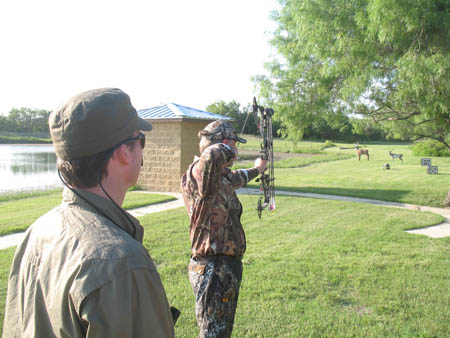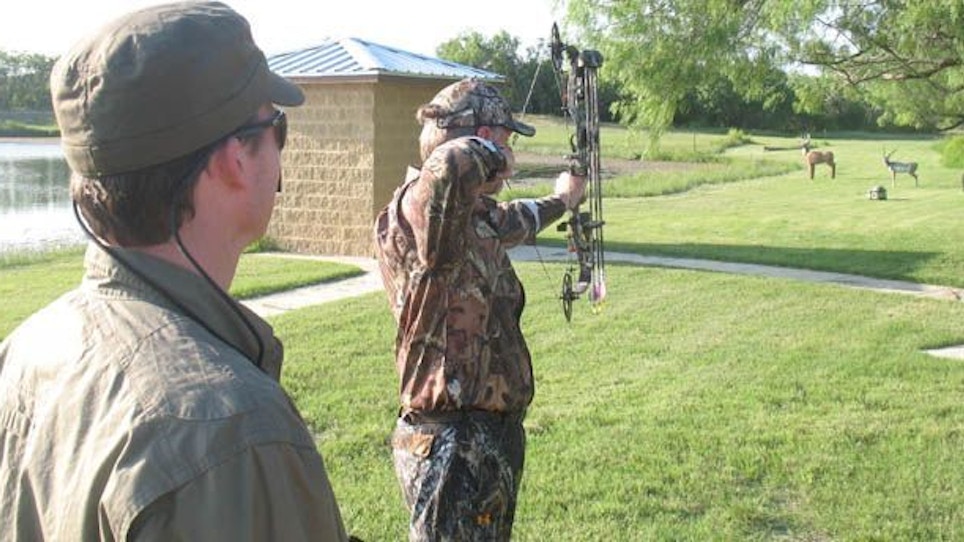 Practice realistically—on 3-D animal targets, with full hunting gear, including broadheads and the clothes you will wear hunting. |
You’ve dreamed for years, planned for months, and spent weeks in the woods. The moment’s finally arrived: An awesome trophy buck is slinking along a trail, a boulder’s throw from your stand.
With confidence built on hours of practice, you slowly raise and draw the bow. But you’re shaking with excitement, and suddenly confused. How should you aim? A pin finally settles on the shoulder, but you’re just not sure. Maybe I’ll be lucky, you think, as the arrow lurches into flight. But only your hopes die today, as you see the shaft sail harmlessly over the buck’s withers and a bowhunter’s chance of a lifetime crashes away. You can only stare after the bobbing flag in heartbreak and disbelief.
For each tale of hunting glory, for each animal taken with a bow, there are a dozen stories like this. I’ve got several of my own. The first arrow I ever shot at a deer missed by three feet, even though it was an easy shot. The biggest, closest buck I’ve ever seen lost a handful of hair but not a drop of blood when my broadhead took him low in the brisket.
In the first analysis, these misses are puzzling. I practice a lot, am a pretty fair shot, and shoot only within my effective range. But when you examine the factors involved in shooting an arrow at game, you begin to see the wide difference between target accuracy and hunting accuracy.
The archer on a target range shoots with no pressure, in a controlled situation, and repeatedly under the same conditions. But when he faces game, it can be at any distance or angle; the archer’s physical position or mental condition may be the worst for shooting an arrow. A friend of mine who has a room full of archery trophies, who regularly shoots quarter-size groups at 20 yards, discovered this the hard way when he completely missed a standing deer at 10 paces.
Keys To Bowhunting Success
There are two things of paramount importance in bowhunting. The first is perseverance. It’s easy enough. You learn to enjoy (or at least endure) boring sits and grueling stalks, or you concede to second-rate success. The other crucial key is the ability to come through at the moment of truth – to make the shot. Months, even years of preparation, as well as thousands of dollars and precious vacation time may be invested in the hopes you can execute a task that takes mere seconds. Many bowhunters work so single-mindedly on getting within range of an animal that they don’t plan what to do once they get there. But preparation will maximize your chance of success at the climax of the hunt. The average bowhunter can train himself to be better than a tournament archer at scoring on game.
This level of excellence is accomplished through practice that is systematic and simulates the real thing. An ambitious bowhunter must train mentally and physically, as well as gain shooting knowledge and woods wisdom, all of which will contribute to his odds of success.
I Know I Can, I Know I Can
Job One is mental preparation. Once an archer has a working knowledge of bow-shooting fundamentals, the most important things for consistent accuracy are control, concentration and confidence. Train yourself to focus attention and be sure of yourself in any situation – but without being cocky or careless. Your attitude should be, I know I can do this job if I give it my fullest effort.
Prepare yourself to face a living, moving, ready-to-bolt target at an uncertain shooting angle. I don’t think a bowhunter ever quite gets used to it. Most archers are aware that the vital zone of a big game animal can be much harder to hit than a target of the same size, but they don’t give it enough thought.
Have you ever found yourself within 20 yards of a trophy animal beyond your wildest dreams? If not, take it from a hunter who learned the hard way: Be prepared. Strandlund’s First Law of Bowhunting reads that the size of an animal’s antlers is proportional to its chances of being missed by arrows. A corollary to that law is that if the animal walks by a bowhunter who has mentally rehearsed the encounter, chances are it will take a ride in a pickup truck.
If we weren’t thrilled by the approach of a game animal, we wouldn’t have much reason to hunt. But bowhunters must learn to control that excitement. First, don’t psych yourself out. You must realize it won’t kill you to blow the shot (unless you’re hunting polar bear, which requires a frame of mind that I cannot explain here). Another method for developing control is visualization.
As you practice, visualize the real thing. Olympic athletes and champions in all shooting sports use this technique to rehearse mentally as well as physically. Pretend that each of your practice shots is at a trophy buck. By the time you are in a real deer-shooting situation, you’ll feel that you’ve been through it a thousand times. It will take away much of the pressure and strangeness of a close encounter with a desirable animal.
To visualize, muster all your imagination and make yourself believe you are in a real hunting situation. Imagine you see the animal approach, stop, and offer only a few seconds to shoot. Raise and draw as if it might see you. Pretend that each and every arrow is your only shot at that buck of a lifetime. If you do it right, you can simulate the pressure you’ll experience in an actual hunting situation. Your heart rate will even increase. Train yourself to shoot accurately under that stress.
Visualization includes not only imagining you are in a real situation. It includes imagining a perfect shot. It’s the power of positive thinking, and it’s been proven to work.
Practice Techniques
It was in a bar in northern Wisconsin that I first heard it: Bow season’s coming up. I guess I got to get out and sight in my compound.
I’ve heard similar statements a couple of times since, and am always baffled. I don’t think it’s a widespread problem. I believe most of us know that we can never attain decent accuracy with archery gear without long hours of practice. But for hunting success, practice must emphasize quality as well as quantity. Practice in a way that enhances your shooting in a hunting situation.
The most important bowhunting fundamental is consistency. For an accurate shot, you need a rock-steady anchor point, string release, and follow-through. In the heat of the moment, this is where the bowhunter makes the most mistakes. A buck has an uncanny ability to make an uncertain shooter lower his anchor point, pluck the string, and lurch after the release. But if you’ve established an absolute shooting style, practiced like a robot, and prepared mentally, it can be just like target shooting.
Experiment with equipment and shooting techniques. Make any needed changes before you begin serious preseason practice. A surprising number of bowhunters fail to tune their bows and arrows as well as they can, then blame their equipment or themselves for lousy shooting. If your hunting arrows don’t fly like your practice shafts, try changing broadheads, fletching, and spine until they do. Because broadheads are expensive and a bother to shoot at targets, most bowhunters don’t experiment enough with them.
Examine your shooting style to see if you need any changes. I improved my instinctive shooting immediately when I switched to a string hold with three fingers beneath the arrow nock. A common mistake is for a hunter to make too much motion as he shoots, either raising the bow in the air as he draws or moving his head and bow arm about as he aims. All game animals are attuned to spotting close-range movement as the most critical sign of danger. If you’re careful to hold still and draw with the bow in shooting position, the only movement visible from the animal’s perspective is the elbow of your string arm extending outward.






